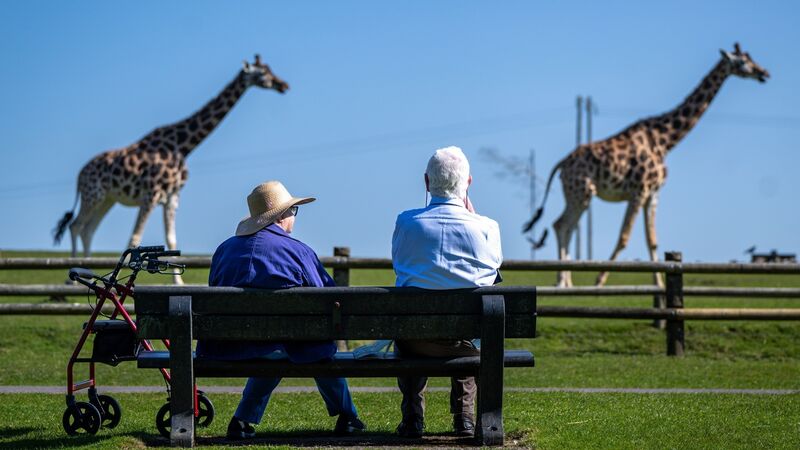Irish Examiner view: Fota Wildlife Park merits State support

Visitors taking in the safari scene earlier this year on the plains at Fota Wildlife Park, Cork — which is both a popular visitor attraction and a major player internationally in breeding programmes to preserve endangered species. Picture: Chani Anderson
This is worrying news for the beloved park in East Cork. The closure is costing Fota €320,000 a month in lost revenue, and officials have estimated that it missed out on as many as 14,000 visitors over the mid-term break alone.
The situation nationally has become more serious after an outbreak of the H5N1 strain of bird flu on a Carlow farm, which is now at the centre of a 3km protection zone and a 10km surveillance zone. Agriculture minister Martin Heydon has also announced the introduction of a compulsory housing order for poultry and captive birds, to protect them from the risk of avian influenza.

That order comes into effect next Monday, which is laudable, but of little use to Fota in the immediate future.
Its director, Aileen Tennant, made this heartfelt plea this week: “At this difficult time, we are asking the public to continue their long-standing support for Fota Wildlife Park.
The park is appealing for support through donations or sponsorship of an animal, and its loyal visitors will no doubt come through for their favourite wildlife park. Fota has been a part of Cork life for generations, and this newspaper endorses its appeal wholeheartedly.
However, the question must be asked: Would Dublin Zoo be left to twist in the wind in similar circumstances? It might be the laziest response imaginable to any crisis which occurs outside the M50, but it is difficult to imagine a comparably sluggish response if the zoo in the capital were affected like this.
Decisive and generous support should be made available to Fota by central Government immediately.
The less salubrious aspects of AI are becoming more and more visible. Those range from the damaging carbon footprint of the data centres and servers needed to power AI to data privacy issues and ethical challenges.
Now, given the evidence heard this week by the Oireachtas AI committee, we may have another concern.
Its members were told by the Irish Deaf Society’s Elaine Grehan, also of the disabled persons’ organisations network, about disabled people’s fears that AI may lead to cutting costs and eliminating jobs carried out by humans.
This is a general concern among many people about AI’s future use, but Grehan also pointed to an entirely different set of challenges.
“AI is not neutral,” she said.
“Disabled people fear AI will reflect existing institutional and structural barriers and attitudes — including biases relating to gender, ethnicity, and impairment — unless there is clear transparency to ensure that structural biases are not built into these systems.
Grehan had a ready-made example on hand, pointing to the inability of AI avatars to decipher sign language due to their lack of understanding of subtle facial expressions.
This was a valuable contribution to the ongoing discourse on AI, because it offered concrete evidence of the inadequacies of this new technology.
AI may become an intrinsic part of our daily lives, as its cheerleaders insist, but it is simply wrong to believe the technology is infallible.
Identifying AI’s specific shortcomings when it comes to some of the most vulnerable people in our society was an even more valuable contribution.
In the headlong rush to adopt the newest and shiniest toy technology has to offer, we must ensure that communities which are often marginalised or neglected are not left behind.
There is, of course, a sharp irony in the fact that being mindful of the vulnerable is a distinctively human trait, and one not immediately associated with AI.
Have the 1990s come back to visit us?
There was a strong sense of déjà vu with the flood of video clips on social media on Wednesday from a concert in Madrid.
It was the opening night of Radiohead’s comeback tour on Tuesday night, which meant that in many parts of the world, forlorn melodies, backing lyrics of angst and disconnection, have been on heavy rotation since.
Thirty years ago, the band made a dazzling career out of their mournful symphonies, becoming a byword for bleak cleverness. Cue one of the most ’90s-coded moments imaginable in popular culture: In 1998, an episode of featured comedian Tommy Tiernan as a depressive priest who is eventually cured of his suicidal tendencies. He’s plunged back into depression when subjected to a gloomy song on the bus: by Radiohead.
That ’90s heyday seems long distant now — little surprise given it is almost 10 years since Radiohead released a new album, and over seven years since they appeared together on stage.
The rapturous welcome they received in the Spanish capital will not be replicated here — London is as close to Ireland as they come — but perhaps they plan more concerts next year.
If they come to Ireland, will it be the ’90s revisited, or just that patented Radiohead sense of creeping dread?












